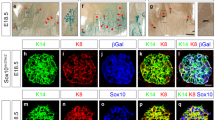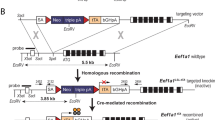Abstract
Mipp is a kelch-related, placental-specific gene that is ectopically expressed in many BALB/c mouse mammary carcinomas of various etiologies. The Kelch family encompasses proteins that are emerging as key links between microfilaments and a variety of cellular structures and functions. Mouse mammary tumors express two mipp transcripts (2.2 and 5.6 kb). We cloned the 2.2 kb mipp mRNA and analysed the product of its 1.7 kb ORF. The 584 residue MIPP protein has an N-terminal BTB domain and six C-terminal tandem Kelch repeats. Despite expression of two mipp RNAs, only a single MIPP protein is expressed in mammary tumors. MIPP protein binds to microfilaments in vitro and co-immunoprecipitates with actin. MIPP co-localized with concanavalin A at the endoplasmic reticulum, suggesting that MIPP might mediate interactions between microtubules and actin filaments. Because MIPP expression is widespread in mouse mammary tumors, it might contribute to tumorigenesis. Although MIPP had little effect on the growth rate of human breast cell lines following transfection, it greatly reduced the formation of duct-like structures on reconstituted basement membrane. Our results suggest that MIPP could contribute to malignant progression in the mouse mammary epithelial cells by perverting their response to cues from the extracellular matrix.
This is a preview of subscription content, access via your institution
Access options
Subscribe to this journal
Receive 50 print issues and online access
$259.00 per year
only $5.18 per issue
Buy this article
- Purchase on Springer Link
- Instant access to full article PDF
Prices may be subject to local taxes which are calculated during checkout




Similar content being viewed by others
References
Albagli O, Dhordain P, Deweindt C, Lecocq G, Leprince D . 1995 Cell Growth Differ 6: 1193–1198
Bork P, Doolittle RF . 1994 J. Mol. Biol. 236: 1277–1282
Callebaut I, Mornon JP . 1998 Cell. Mol. Life Sci. 54: 880–891
Cardiff RD, Aguilar-Cordova E . 1988 Anticancer Res. 8: 925–933
Carraway KL, Carraway CAC . 1992 The Cytoskeleton: a practical approach IRL Press at Oxford University, New York
Chang-Yeh A, Mold DE, Brilliant MH, Huang RC . 1993 Proc. Natl. Acad. Sci. USA 90: 292–296
Chang-Yeh A, Mold DE, Huang RC . 1991 Nucleic Acids Res. 19: 3667–3672
Eichinger L, Bomblies L, Vandekerckhove J, Schleicher M, Gettemans J . 1996 EMBO J. 15: 5547–5556
Goode BL, Drubin DG, Barnes G . 2000 Curr. Opin. Cell. Biol. 12: 63–71
Gould MN . 1995 Semin. Cancer Biol. 6: 147–152
Gregory RB, Wilcox RA, Berven LA, van Straten NC, van der Marel GA, van Boom JH, Barritt GJ . 1999 Biochem. J. 341: 401–408
Hernandez MC, Andres-Barquin PJ, Martinez S, Bulfone A, Rubenstein JL, Israel MA . 1997 J. Neurosci. 17: 3038–3051
Horton P, Nakai K . 1997 ISMB 5: 147–152
Kim IF, Mohammadi E, Huang RCC . 1999 Gene. 228: 73–83
Laemmli UK . 1970 Nature 227: 680–685
Lueders KK, Kuff EL . 1977 Cell 12: 963–972
Mata J, Nurse P . 1997 Cell 89: 939–949
Medina D . 1988 Carcinogenesis 9: 1113–1119
Medina D, Daniel C . 1996 J. Mammary Gland Biol. Neoplasia 1: 3–4
Medina D, Kittrell FS . 1993 Carcinogenesis 14: 25–28
Medina D, Kittrell FS, Liu YJ, Schwartz M . 1993 Cancer Res. 53: 663–667
Prinz WA, Grzyb L, Veenhuis M, Kahana JA, Silver PA, Rapoport TA . 2000 J. Cell Biol. 150: 461–474
Ribeiro CM, Reece J, Putney Jr JW . 1997 J. Biol. Chem. 272: 26555–26561
Robinson DN, Cooley L . 1997 J. Cell Biol. 138: 799–810
Sanders MC, Way M, Sakai J, Matsudaira P . 1996 J. Biol. Chem. 271: 2651–2657
Schmid MF, Agris JM, Jakana J, Matsudaira P, Chiu W . 1994 J. Cell Biol. 124: 341–350
Schmucker B, Ballhausen WG, Kressel M . 1997 Eur. J. Cell. Biol. 72: 46–53
Selden SC, Pollard TD . 1986 Ann. NY Acad. Sci. 466: 803–812
Soltysik-Espanola M, Rogers RA, Jiang S, Kim TA, Gaedigk R, White RA, Avraham H, Avraham S . 1999 Mol. Biol. Cell. 10: 2361–2375
Tabb JS, Molyneaux BJ, Cohen DL, Kuznetsov SA, Langford GM . 1998 J. Cell. Sci. 111: 3221–3234
Terasaki M . 1990 Cell. Motil Cytoskeleton 15: 71–75
VanHouten JN, Natoli F, Asch BB . 1996 Oncogene 12: 2241–2245
Waterman-Storer CM, Salmon E . 1999 Curr. Opin. Cell. Biol. 11: 61–67
Wood JG, Byrd FI, Gurd JW . 1981 J. Neurocytol 10: 149–159
Xue F, Cooley L . 1993 Cell. 72: 681–693
Acknowledgements
We thank Dr Linda Varela for her gift of EHS matrix. This work was supported by Predoctoral Fellowship DAMD 17-96-1-6048 from the Department of the Army's Breast Cancer Research Program and by grants CA62014, CA72768, and Roswell Park Cancer Institute's CCSG CA16056 from the NCI, NIH.
Author information
Authors and Affiliations
Corresponding author
Rights and permissions
About this article
Cite this article
VanHouten, J., Asch, H. & Asch, B. Cloning and characterization of ectopically expressed transcripts for the actin-binding protein MIPP in mouse mammary carcinomas. Oncogene 20, 5366–5372 (2001). https://doi.org/10.1038/sj.onc.1204701
Received:
Revised:
Accepted:
Published:
Issue Date:
DOI: https://doi.org/10.1038/sj.onc.1204701



